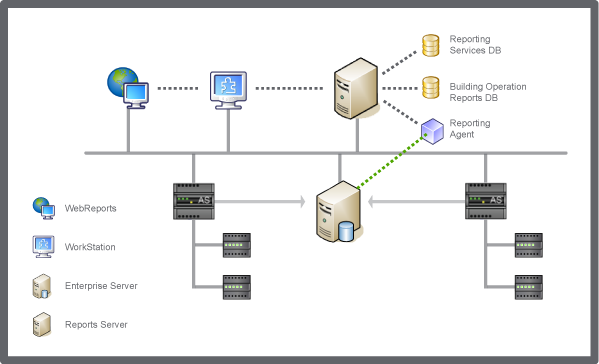
Concept
WebReports Components
The basic WebReports components are a web browser, the Reports Server (running WebReports and prerequisite software), the Enterprise Server (running WorkStation) and (optionally), one or more SmartStruxure server devices.
WebReports employs a Web client/server architecture to generate reports in both WorkStation and a Web browser. Microsoft ASP.NET provides the server Web technology and object-oriented programming environment for designing WebReports. The following illustration shows an overview of the WebReports components.

WebReports components
WebReports
WebReports is the Web application that sends requests for reports and administers the Reports Server. In addition, the application provides the user interface for viewing, creating, and managing reports. You can perform these functions by logging on to the WebReports Web site using a Web browser. Within WorkStation, WebReports generates reports for viewing and provides the mechanism for creating reports.
WorkStation and the WebReports Web Site
From WorkStation, you configure WebReports using Report Manager. After you configure WebReports, you can create and view reports in the Work area of WorkStation. If you do not configure WebReports, you cannot view and create reports in WorkStation. For more information, see WebReports Configuration .
Using a Web browser, you can log on to the WebReports Web site. You can then create and view reports. In addition, if you have Reports Administrator privileges, you can perform the following administrative tasks:
Upload images to be used in your reports.
Assign templates to default reports.
Upload and download report packs.
Schedule dashboard reports to run on defined dates and times.
Rename and delete custom reports.
Enterprise Server
The Enterprise Server hosts the Configuration database, the Historical database, and the Runtime database and aggregates the data from the SmartStruxure server devices in your building automation control system. The databases store current information, such as trend, alarm, and user activity, from the SmartStruxure server devices. The databases also store object property information such as the name and description of objects. The database information from the Enterprise Server is used in your reports.
The Enterprise Server whose database information is used in your reports is specified during the installation of WebReports. As such, the Enterprise Server is a required component in your building automation control system. You can only use WebReports when there is an Enterprise Server in your building automation control system.
When you want to use WebReports in WorkStation, you need to log on to the Enterprise Server that was specified during the WebReports installation. You specify the Enterprise Server in the log on window of WorkStation.
SmartStruxure Server Devices
Each SmartStruxure server devices is an embedded device in your system and has a Configuration database, Historical database, and Runtime database. Data from the SmartStruxure server device including trends, points, and units are used in reports, such as the Trend Log Comparison report; however, building automation control systems that only have SmartStruxure server devices cannot use WebReports. The Enterprise Server is a required component. As such, the configuration of your building automation control system needs to include an Enterprise Server. When you want to use WebReports in WorkStation, you need to log on to the Enterprise Server that was specified during the WebReports installation. You do not log on to a SmartStruxure server device.
Reporting Agent
The Reporting Agent is a Windows service that performs reads of historical data, such as events, alarms, and extended trends, to be used in the reports that you generate in WebReports.
Reports Server
The Reports Server is the computer where the Reporting Services database and the Building Operation Reports database reside. The databases are created and configured during the installation of SQL Server and WebReports.
The Reporting Services database stores the Report Definition Layout Files or templates that define the characteristics of the reports including the following elements:
Page style elements such as fields, fonts, images, graphs, tables
Field attributes and parameters
Database connections and queries for pulling data into the report
The Building Operation Reports database is used for generating reports. The database stores report content such as trend, alarm, and SmartStruxure server information, and user account and group information.
Following the installation of WebReports, you access the WebReports Web site by specifiying the URL of the Reports Server. The URL includes the IP address of the Reports Server, a root directory, and the file name of the WebReports log on page. For example, http://10.159.16.246/SchneiderElectric/WebReports/Login.aspx.
The computer to be used as the Reports Server is determined by the person who installs WebReports. The Reports Server may or may not be the same computer where the Enterprise Server is installed. You do need to know the URL of the Reports Server in order to configure Report Manager in WorkStation. For more information, see WebReports Configuration .
 WebReports Overview
WebReports Overview
 WebReports Configuration
WebReports Configuration